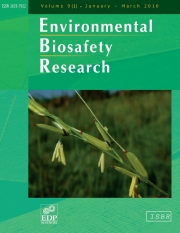Article contents
Potential adoption and management of insect-resistant potato in Peru, and implications for genetically engineered potato
Published online by Cambridge University Press: 16 March 2006
Abstract
This paper analyzes some important issues surrounding possible deployment of genetically engineered (GE) insect-resistant potato in Peru, based on a large farmer survey held in Peru in 2003. We found that the formal seed system plays a limited role compared with the informal seed system, especially for smallholder farmers. Although 97% of smallholder farmers would buy seed of an insect-resistant variety, a majority would buy it only once every 2 to 4 years. Survey data show that farmers would be willing to pay a premium of 50% on seed cost for insect resistant varieties. Paying price premiums of 25% to 50%, farmers would still increase their net income, assuming insect resistance is high and pesticide use will be strongly reduced. Of all farmers, 55% indicated preference for insect-resistant potato in varieties other than their current varieties. The survey indicates that smallholder farmers are interested to experiment with new varieties and have a positive perception of improved varieties. Based on these findings, and considering the difficulties implementing existing biosafety regulatory systems such as those in place in the U.S. and E.U., we propose to develop a variety-based segregation system to separate GE from conventionally bred potatoes. In such a system, which would embrace the spread of GE potatoes through informal seed systems, only a limited number of sterile varieties would be introduced that are easily distinguishable from conventional varieties.
- Type
- Research Article
- Information
- Copyright
- © ISBR, EDP Sciences, 2006
References
- 3
- Cited by


